Cengage Financial Algebra 1st Edition Chapter 2 Exercise 2.4 Modeling a Business
Page 81 Problem 1 Answer
Given that expense function for a certain product is E=3.40q+189,000
We have to express the average cost of producing q items algebraically.
Now we have the total cost for the q items as
E=3.40q+189,000
Now we have the average cost of producing as the total cost is divided by the total number of items that is
3.40q+189,000/q
Average cost=3.40+189,000/q
Hence we have the average cost of producing q items algebraically is 340+189,000/q
Page 83 Problem 2 Answer
We have the expense function, E=5.00q+60,000
And the revenue function, R=7.00q.
Now we have the breakeven point, set the revenue and expense equations equal to each other.
On equating we have
E=R
5.00q+60,000=7.00q
2q=60,000
q=30,000
So we have the breakeven point as q=30,000
Hence we have the breakeven point as q=30,000
Read and Learn More Cengage Financial Algebra 1st Edition Answers
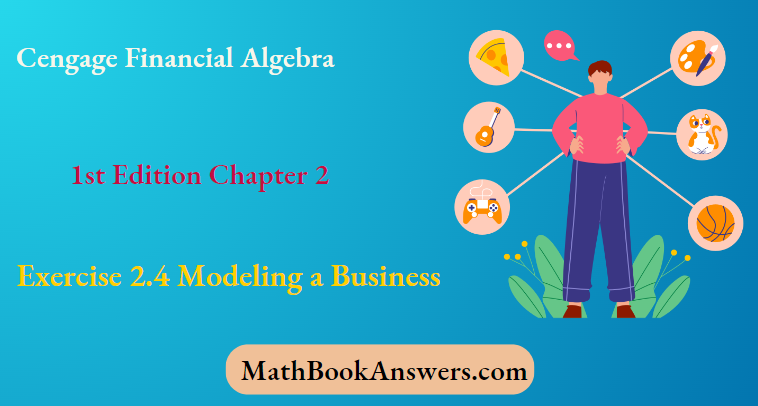
Page 84 Problem 3 Answer
Given the statement as
An economist is an expert who will know tomorrow why the things he predicted yesterday didn’t happen today.
We have to interpret the quote.
If we predict about something yesterday then that predictions will be based on many variables and if any one of the variables changes slightly then it leads to different result today.
Therefore If we predict about something yesterday then that predictions will be based on many variables and if any one of the variables changes slightly then it leads to different result today.
Cengage Financial Algebra 1st Edition Chapter 2 Exercise 2.4 Modeling A Business Solutions
Cengage Financial Algebra 1st Edition Chapter 2 Exercise 2.4 Modeling a Business Page 84 Problem 4 Answer
Given that the Gidget Widget Corporation produces widgets.
The fixed expenses are $65,210 and the variable expenses are $4.22 per widget.
We have to express the expense function algebraically.
Let us assume that E be the total expense And let us assume q as the number of widgets
Now we know that the total expense as sum of expenses is the sum of fixed expenses plus the variable expenses we have
E=65210+4.22q
So we have the expense function algebraically as E=65210+4.22q
We have the expense function algebraically asE=65210+4.22q
Page 84 Problem 5 Answer
Given that A corporation produces mini-widgets.
The fixed expenses are $142,900 and the variable expenses are $1.24 per mini-widget.
We have to find how much does it cost to produce 1 mini-widget
Let us assume that E be the total expense
And Given that the number of widgets be 1
Now we know that the total expense as sum of expenses is the sum of fixed expenses plus the variable expenses we have
E=1.24×1+142,900
=142,901.24
So we have obtained the cost to produce 1 mini-widget is $142,901.24
Hence the cost to produce 1 mini-widget is $142,901.24
Cengage Financial Algebra 1st Edition Chapter 2 Exercise 2.4 Modeling a Business Page 84 Problem 6 Answer
Given that A corporation produces mini-widgets.
The fixed expenses are $142,900 and the variable expenses are $1.24 per mini−widget.
We have to find how much does it cost to produce 20,000 mini-widget
Let us assume that E be the total expense
And Given that the number of widgets be 20000
Now we know that the total expense as sum of expenses is the sum of fixed expenses plus the variable expenses we have
E=1.24×20,000+142,900
=24,800+142,900
=167,700
So we have obtained the cost to produce 20000 mini-widget is $167,700
Hence the cost to produce 20000 mini-widget is $167,700
Page 84 Problem 7 Answer
Given that A corporation produces mini-widgets.
The fixed expenses are $142,900 and the variable expenses are $1.24 per mini−widget.
We have to express the expense function algebraically.
Let us assume that E be the total expense And let us assume q as the number of widgets
Now we know that the total expense as sum of expenses is the sum of fixed expenses plus the variable expenses we have
E=1.24q+142,900
So we have the expense function algebraically as E=1.24q+142,900
We have the expense function algebraically as E=1.24q+142,900
Cengage Financial Algebra Chapter 2 Exercise 2.4 Modeling A Business Answers
Page 84 Problem 8 Answer
From the above problem we have the expense function algebraically as E=1.24q+142,900
We have to find the slope of the expense function
As we have the expense function algebraically as E=1.24q+142,900
Now on comparing with the general form of the equation y=mx+c
We can say that the slope as 1.24
So we have the slope of the expense function as 1.24
Cengage Financial Algebra 1st Edition Chapter 2 Exercise 2.4 Modeling a Business Page 84 Problem 9 Answer
Given that A corporation produces mini-widgets.
The fixed expenses are $142,900 and the variable expenses are $1.24 per mini−widget.
We have to give the units that would be used.
As we have the slope as of form dy/dx
That is nothing but the units of y gets divided with the units of x
As we have the y as price so we have the unit as dollars similarly we have x as number of mini widgets.
So we will have the unit of slope as dollars per mini -widgets.
Hence we have the units of slope as dollars per mini-widgets.
Page 84 Problem 10 Answer
We have the expense function for the Wonder Widget is E=4.14q+55,789
We have to find what is the fixed cost in the expense function
We have the expense function as E=4.14q+55,789
We will get the fixed cost in the expense function by substituing the value of number of mini-widgets as zero that is q=0
So we have the fixed cost as
Fixes cost =4.14(0)+55,789
=55,789
So we have the fixed cost in the expense function as $55,789
Hence we have the fixed cost in the expense function as $55,789
Page 84 Problem 11 Answer
In the above question they have given expense function of Wonder widgets
E=4.14q+55,789
We need to find the value cost producing for 500 woder widgets
Given
E=4.14q+55,789
The cost of producing q number of widgets is given by the equation replace q with 500 to find the cost of 500 widgets
E=4.14(500)+55,789
=2,070+55,789
=57859
Hence the total value of cost producing 500 wonder widgets are 57859.
Cengage Financial Algebra 1st Edition Chapter 2 Exercise 2.4 Modeling a Business Page 84 Problem 12 Answer
In the above question they have given expense function of Wonder widgets
E=4.14q+55,789
We need to find the value cost producing for 500 woder widgets
Given
E=4.14q+55,789
We have found the cost of producing 500 widgets in previous part and it is 57859
Average cost for 500 widgets will be cost/500
Average cost =$57,859/500
=$115.718
≈$115.72
Therefore average cost per producion 500 wonder widgets are 115.72
Page 84 Problem 13 Answer
In the above question they have given expense function of Wonder widgets
E=4.14q+55,789
We need to find the value cost producing for 500 woder widgets
Given
E=4.14q+55,789
The cost of producing q number of widgets is given by the equation replace q with 600 to find the cost of 600 widgets
E=4.14(600)+55,789
=2,484+55,789
=58,273
The total cost of producing 600 Wonder Widgets are 58,273.
Page 84 Problem 14 Answer
In the above question they have given expense function of Wonder widgets
E=4.14q+55,789
We need to find the value cost producing for 500 woder widgets
Given
E=4.14q+55,789
We have found the cost of producing 600 widgets in previous part and it is58273
Average cost for 600 widgets will be cost/ 600
Average cost=$58,273/600
=$97.12166
≈$97.12
The average cost per600
Wonder widgets is 97.12.
Solutions For Cengage Financial Algebra Chapter 2 Exercise 2.4 Modeling A Business
Cengage Financial Algebra 1st Edition Chapter 2 Exercise 2.4 Modeling a Business Page 84 Problem 15 Answer
In the above question they have given expense function of Wonder widgets
E=4.14q+55,789
We need to As the number of widgets increased from 500 to 600 did the average expense per widget increase or decrease
Given
E=4.14q+55,789
$115.72 Average cost per widget in case of 500
$97.12 Average cost per widget in case of 600
As 115.72 is greater than 97.12 it decreased
Therefore As the number of widgets increased from 500 to 600 the average expense per widget decreased.
Page 84 Problem 16 Answer
In the above question they have given expense function of Wonder widgets
E=4.14q+55,789
We need to find the average cost per widgets of producing 10,000 wonder widgets
Given
E=4.14q+55,789
The cost of producing q number of widgets is given by the equation replace q with 10,000 to find the cost of 10,000 widgets
E=4.14(10,000)+55,789
=41,400+55,789
=97,189
Average will be cost/10,000
Average cost=$97,189/10,000
=$9.7189
≈$9.72
The average cost per producing 10000 wonder widgets are 9.72.
Cengage Financial Algebra 1st Edition Chapter 2 Exercise 2.4 Modeling a Business Page 84 Exercise 1 Answer
Given
q=−140p+9,000
E=2q+16,000
We need to express expense equation interms of p.
Given
q=−140p+9,000
E=2q+16,000
Substitute the value of q in terms of p in equation for E
E=2(−140p+9,000)
=−280p+18,000
Expense function in term s of p is E=−280p+18,000
Page 84 Exercise 2 Answer
Given
q=−140p+9,000
E=2q+16,000
we need to find no. of widgets are demanded at a price of$ 10.00.
The demand function q is given by q= -140p+9,000
p is price
Now to find demand at price =$10 find q at p = 10
q=-140(10)+9,000
=7,600
Therefore 7,600 widgets are needed.
Page 84 Exercise 3 Answer
Given
q=−140p+9,000
E=2q+16,000
we need to find cost to produce the number of widgetsfrom part b
Cost(Expense) function is given by
E=2q+16,000
q is number of widgets to be produced
Here q=7,600(from part b)
E=2(7,600)+16,000
=31,200
The total cost to produce 7600 widgets is 31200.
Cengage Financial Algebra 1st Edition Chapter 2 Exercise 2.4 Modeling a Business Page 84 Exercise 4 Answer
Given, expense equation as E=11.00q+76,000
Price of $20.00
We need to find items must be sold to reach the breakeven point to fin breakeven point revenue= Expense
Revenue=20q
Equate both and find a
20q=11q+76,000
3.9q=76,000
q=8,444.44 or 8,444
8,444 items must be sold to reach the breakeven point.
Page 84 Exercise 5 Answer
Given
Revenue =20q
Expense =11q+76,000
We need to plot the graph and find the q value.
Ploting the graph of E and R

Hence q value is 8,444
The q value of exersice 9 and graph matches.
Page 84 Exercise 6 Answer
Given
E=4.98q+69,000
E′=4.55q+69,000
The expense equation was recently adjusted from E to E′ in response to the increase in gas prices
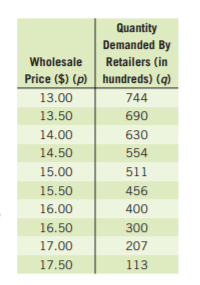
We need find the incerase in the average cost per widget
Given
E=4.98q+69,000
E′=4.55q+69,000
Find the difference of new cost and previous cost
E−E′ =4.98q+69,000−(4.55q+69,000)
=0.43q
So increase in average cost for 1 widget can be found by substituting q=1 in the difference
0.43(1)=0.43
0.43 is the increase in the average cost per widget.
Cengage Financial Algebra Exercise 2.4 Modeling A Business Key
Cengage Financial Algebra 1st Edition Chapter 2 Exercise 2.4 Modeling a Business Page 84 Exercise 7 Answer
Given
E=4.98q+69,000
E′=4.55q+69,000
The expense equation was recently adjusted from E to E′ in response to the increase in gas prices
Price p=8
We need to find breakeven point prior to the adjustment in the expense function.

To find breakeven point Revenue= expense
Revenue=8q
Expense=4.55q+69,000
equate both and find q
8q=4.55q+69,000
3.3.45q=69,000
q=20,000
E at q =20,000
E= 4.55(20,000)+69,000
=160,000
20,000 items are sold at breakeven point at the cost 160,000
Page 84 Exercise 8 Answer
Given
E=4.98q+69,000
E′=4.55q+69,000
The expense equation was recently adjusted from E to E′ in response to the increase in gas prices
Price p=8.5
We need to find breakeven point after the adjustment in the expense function
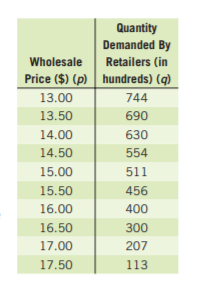
To find breakeven point Revenue= expense
Revenue =8.5q
Expense =4.98q+69,000
Equate both and find q
8.5q=4.98q+69,000
3.3.52q=69,000
q=19,602.27 or 19,602
E at q=19,602
E=4.98(19,602)+69,000
=166,617.96 or 166,618
items are sold at breakeven point at the cost166,618 .
Page 84 Exercise 9 Answer
In the above question they have given a graph We need to observe the graph and answer the question
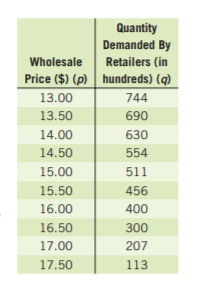
” What is the breakeven point?”
Answer:-
Breakeven point is the point at which revenue = expense and this can be seen that point of intersection of both lines is (A,W)
The break even point is from (A,W).
Page 84 Exercise 10 Answer
In the above question they have given a graph
We need to observe the graph and answer the question
If quantity C is sold and C<A, is there a profit or a loss? Explain.
Answer:-
Drop a vertical line at q<A
then it is visible that revenue is less than expense and hence we can say there will be loss
Hence there will be loss.
Cengage Financial Algebra 1st Edition Chapter 2 Exercise 2.4 Modeling a Business Page 84 Exercise 11 Answer
In the above question they have given a graph
We need to observe the graph and answer the question
If quantity D is sold and D>A, is there a profit or a loss? Explain.
Answer:-
Drop a vertical line at q>A then it is visible that revenue is higher than expense and hence we can say there will be profit.
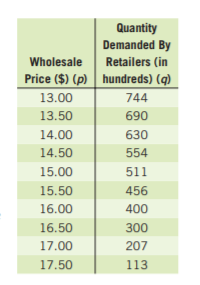
Hence there will be a profit.
Page 84 Exercise 12 Answer
In the above question they have given a graph
We need to observe the graph and answer the question
The y−intercept of the expense function is Z.
Interpret what the company is doing if it operates at the point (0,Z).
Answer:-
If company is operating at(0,Z) that means company is not producing any product but still has to pay Z
dollars for the fixed expenses and yes company will be definitely in loss of Z dollars.
Hence the selling no goods but paying Z dollars for fixed expenses.
Page 85 Exercise 13 Answer
Given
E=6.21q+125,000
p=19.95
we need to represent the average expence A for one nokee algebraically.
Given
E for q number of goods is E=6.21q+125,000
Average expense if given by expense for q number of goods divided by q
E=6.21q+125,000/q.
Hence Average expence A for one nokee algebrically is E=6.21q+125,000/q.
Page 85 Exercise 14 Answer
Given
E=6.21q+125,000
p=19.95
we need to represent graph the average expense function.
Plotting the graph
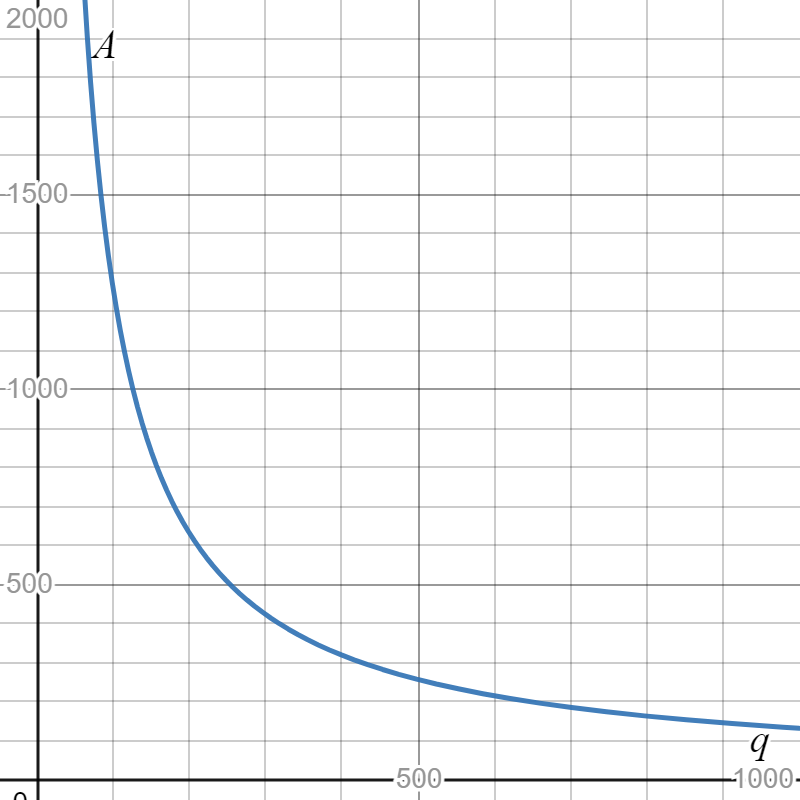
Set the range of x 0 to 1000
range of y 0 to 2000 and the value of y=6.21+(125,000/x)
Hence the graph is plotted
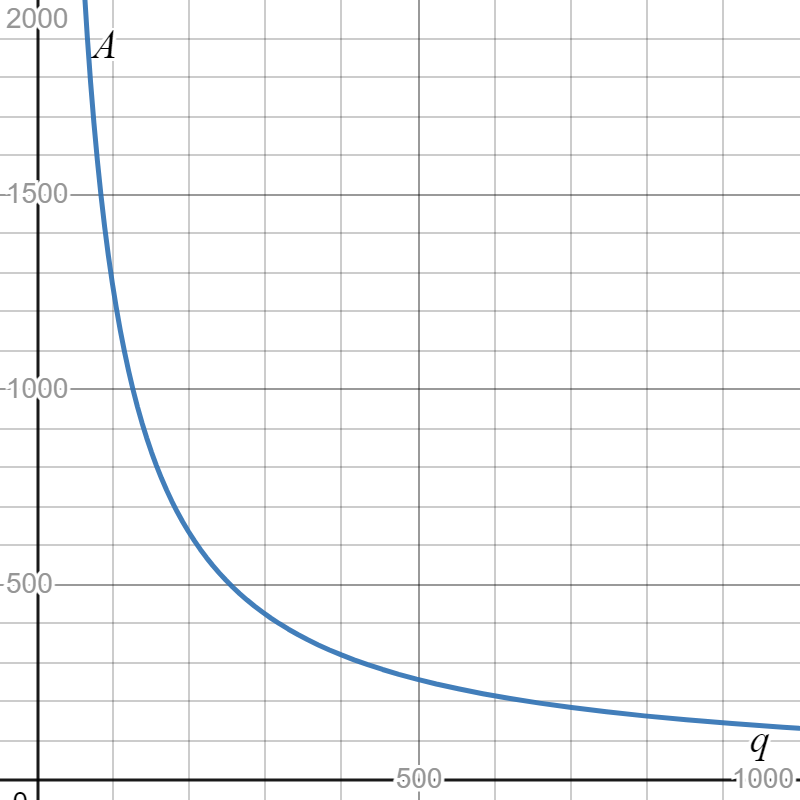
Detailed Solutions For Cengage Financial Algebra Chapter 2 Exercise 2.4
Cengage Financial Algebra 1st Edition Chapter 2 Exercise 2.4 Modeling a Business Page 85 Exercise 15 Answer
Given
E=6.21q+125,000
p=19.95
we need to verify whether the average expense is linear or not.
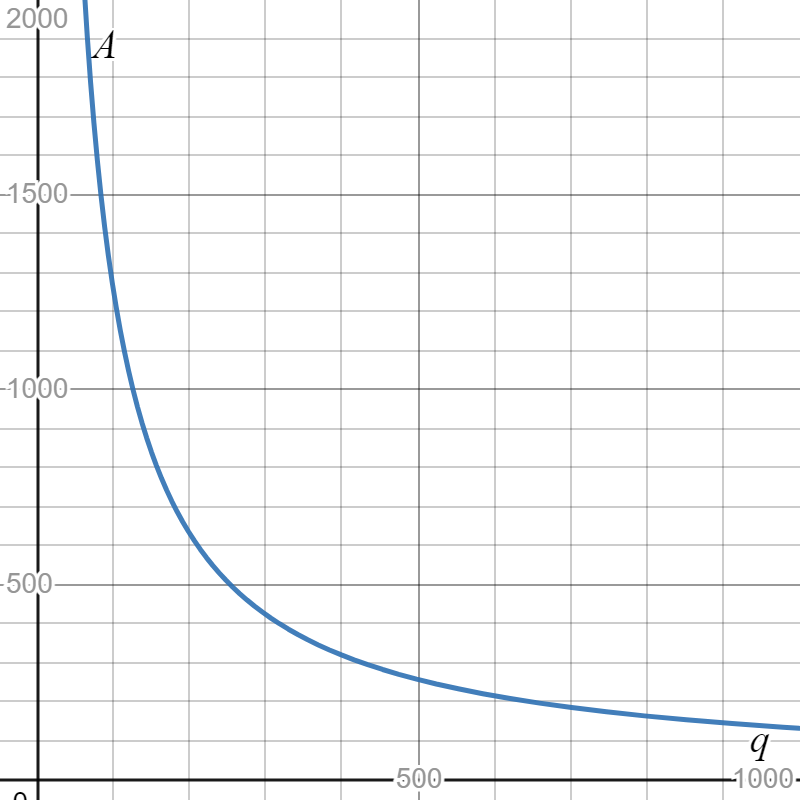
By observing the graph
As seen in 13 b the graph of average expense is not linear.
The average expense function is not linear.
Page 85 Exercise 16 Answer
Given
E=6.21q+125,000
p=19.95
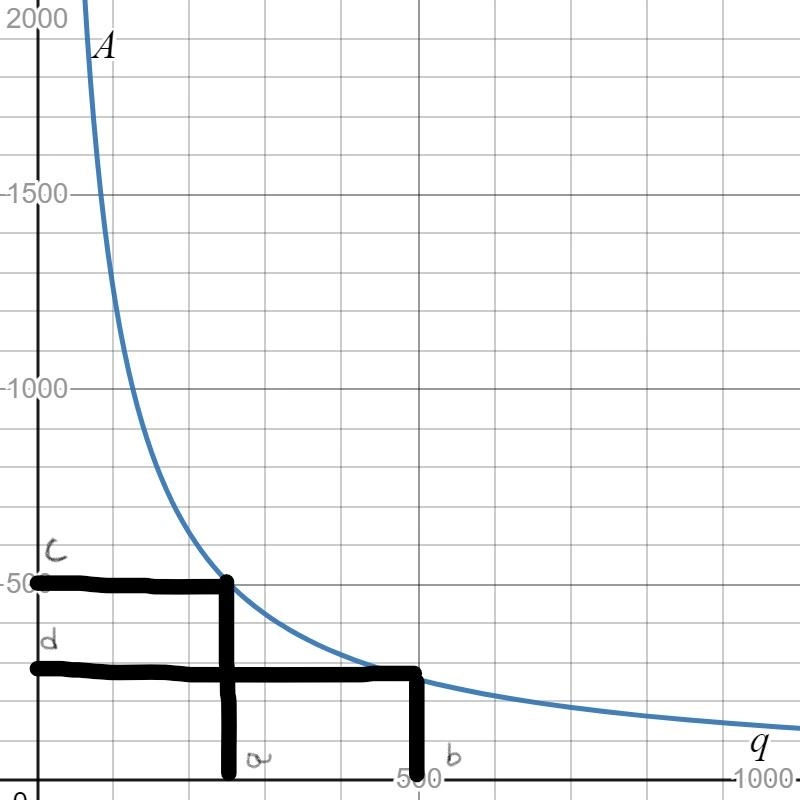
we need to find whether the expence function is increasing or decreasing as q increasing.
Hence verage expense function increasing or decreasing as q increases.
Page 85 Exercise 17 Answer
Given
E=6.21q+125,000
p=19.95
if only one Nokee is produced we need to find the average cost per nokee
E for q number of goods is E=6.21q+125,000
Average expense if given by expense for q number of goods divided by q
E=6.21q+125,000/q
For 1 put q=1
6.21+125,000/1
=125,006.21
If only one Nokee is produced, what is the average cost per Nokee125,006.21.
Cengage Financial Algebra 1st Edition Chapter 2 Exercise 2.4 Modeling a Business Page 85 Exercise 18 Answer
Given
E=6.21q+125,000
p=19.95
if 100,000 Nokee is produced we need to find the average cost per nokee
E for q number of goods is E=6.21q+125,000
Average expense if given by expense for q number of goods divided by q
E=6.21q+125,000/q
For 100,000 put q=100,000
6.21(100,000+125,000
100,000
=7.46
If 100,000 Nokees are produced, then the average cost per Nokee 7.46
Page 85 Exercise 19 Answer
In the above question they have given that Lorne has determined the fixed cost of producing his new invention is N dollars.
Variable cost is $ 10.75
We need to find average cost per item.
Remember ,fixed expenses do not depend on the quality produced.
Thus, regradless of how big ‘W’ is, the fixed cost would still be N.
First find the total cost of producing W items:
=$10.75W+N
Divide by W to find average per item:
=$10.75W+N/W
=$10.75W/W+N/W
=$10.75+n/w
Hence the average cost per producing W item is $10.75+N/W.
Practice Problems For Cengage Financial Algebra Exercise 2.4 Modeling A Business
Chapter 2 Solving Linear Inequalities
- Cengage Financial Algebra 1st Edition Chapter 2 Assessment Modeling a Business
- Cengage Financial Algebra 1st Edition Chapter 2 Exercise 2.1 Modeling a Business
- Cengage Financial Algebra 1st Edition Chapter 2 Exercise 2.2 Modeling a Business
- Cengage Financial Algebra 1st Edition Chapter 2 Exercise 2.3 Modeling a Business
- Cengage Financial Algebra 1st Edition Chapter 2 Exercise 2.5 Modeling a Business
- Cengage Financial Algebra 1st Edition Chapter 2 Exercise 2.6 Modeling a Business
- Cengage Financial Algebra 1st Edition Chapter 2 Exercise 2.7 Modeling a Business
- Cengage Financial Algebra 1st Edition Chapter 2 Exercise 2.8 Modeling a Business
